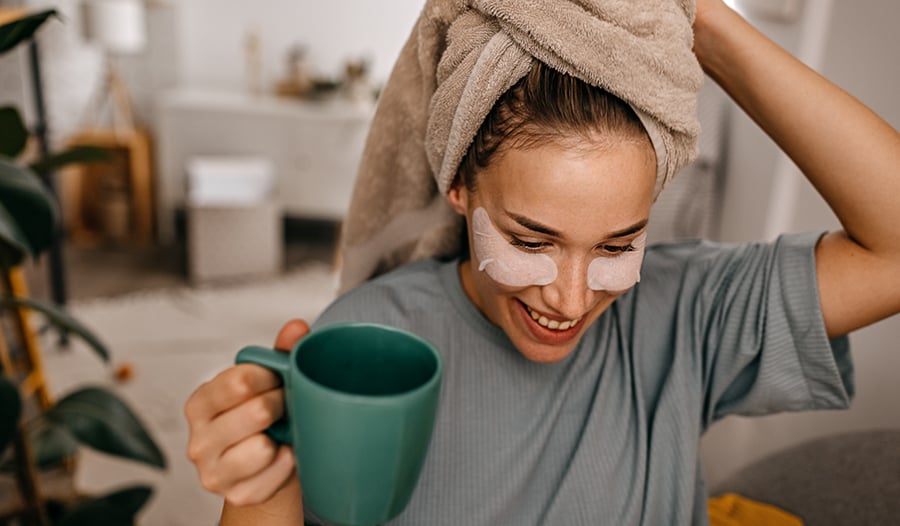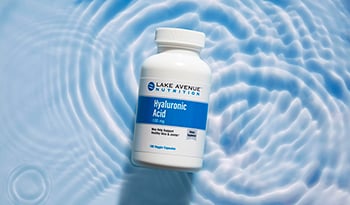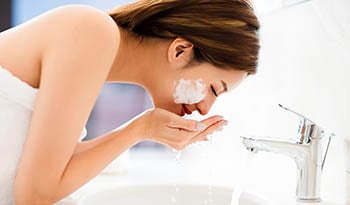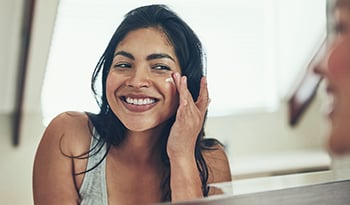Caffeine in Skincare: Antioxidant + Anti-Inflammatory Benefits and More
DISCLAIMER:This blog does not intend to provide diagnosis...
- In this article:
- Antioxidant Benefits of Caffeine on the Skin
- Anti-Inflammatory Benefits of Caffeine on the Skin
- Circulatory Benefits of Caffeine on the Skin
- How to Incorporate Oral and Topical Caffeine

How much do you love your morning coffee? If you’re a caffeine fanatic like me, I have good news. Caffeine isn't just a great way to perk up your brain—it can also invigorate your skin!
Caffeine is a popular stimulant that is consumed daily by millions of people around the world. Caffeine is a natural compound in coffee, tea, and other plant-based foods. It belongs to a class of compounds known as methylxanthines, known for their stimulating effects on the body.
When consumed, caffeine works by blocking the action of adenosine, a neurotransmitter responsible for making us feel tired and sleepy. This increases alertness and mental clarity, so many people turn to caffeine to start their day.
While most people are familiar with the effects of caffeine on the brain, many are unaware of its potential benefits for the skin. In recent years, caffeine has emerged as a popular ingredient in many skincare products, especially those targeted at reducing the appearance of under-eye circles, wrinkles, and fine lines. Caffeine’s benefits on the skin are primarily due to three of its significant properties:
- Antioxidant
- Anti-inflammatory
- Circulatory
In this article, we’ll take a closer look at the science behind caffeine and how it can help improve your skin’s health and appearance.
Antioxidant Benefits of Caffeine on the Skin
Caffeine provides potent antioxidants that may help protect the skin from oxidative damage and improve its youthful appearance. Antioxidants are molecules that help counteract the damage caused by oxidative stress (free radical damage). Ultraviolet (UV) light from the sun, pollution, and other environmental factors can cause free radical damage. In the skin, free radical damage causes the breakdown of cellular DNA and vital skin proteins like collagen and elastin.
Collagen is a vital protein that plays a crucial role in maintaining the health and structure of the skin. It is the most abundant protein in the body and a major component of the extracellular matrix (ECM), which provides structural support to tissues and organs. Collagen is responsible for giving skin its structure and firmness.
As we age, collagen production in the skin naturally declines, and free radical damage degrades collagen. This results in the formation of wrinkles, fine lines, and sagging skin. Antioxidants like caffeine may help minimize some of the free radical damage to collagen, leading to more youthful-appearing skin.
Elastin is a protein that works in tandem with collagen to provide elasticity and resilience to the skin. It is a flexible protein that can stretch and recoil back to its original shape, allowing the skin to stretch and contract without losing shape. Elastin fibers are found in the dermis layer of the skin and are responsible for the skin's ability to bounce back after it has been pulled or pinched.
As we age, elastin production in the skin decreases, leading to a loss of skin elasticity. This can result in sagging and wrinkles. Free radical damage from UV rays also damages elastin, making the skin appear more sallow, yellow, and lackluster. Antioxidants, like caffeine, may help minimize this damage and contribute to a brighter, more radiant complexion.
Anti-Inflammatory Benefits of Caffeine on the Skin
Caffeine reduces the production of pro-inflammatory cytokines, molecules that contribute to inflammation in the body. This anti-inflammatory action may help reduce redness, irritation, and puffiness in the skin and can be particularly helpful for people with sensitive skin, acne, or rosacea.
One large study found that people who drank caffeine—particularly caffeinated coffee—had lower rates of rosacea. Increased caffeine intake from foods other than coffee (tea, soda, and chocolate) was not significantly associated with decreased risk of rosacea. This suggests something special about caffeinated coffee, particularly that correlates with rosacea risk.
In several large studies, caffeinated coffee and black tea were also associated with lower rates of skin cancer. Although the association between caffeine intake and lower rates of skin cancer is clear, it’s unclear whether caffeine lowers the risk of skin cancer—people who consume caffeine may have a lower risk of skin cancer for other reasons. However, caffeine’s anti-inflammatory and antioxidative mechanisms, which counteract UV damage, support the hypothesis that caffeine intake could help fight the development of skin cancers.
Circulatory Benefits of Caffeine on the Skin
Caffeine affects the circulatory system in complex ways. In some circumstances, it is a vasoconstrictor, meaning it causes blood vessels to constrict or shrink. In other situations, caffeine causes vasodilation and increases circulation.
Because of its effects on circulation, caffeine may minimize the appearance of redness or purplish/blue shadows caused by blood vessels seen through the skin. Its diuretic effects can also help reduce puffiness. With its anti-inflammatory, antioxidant, and circulatory properties, caffeine is a common ingredient in eye creams.
How to Incorporate Oral and Topical Caffeine
Both oral and topical caffeine formulations have anti-inflammatory, antioxidant, and circulatory effects on the skin.
Caffeine is found in a variety of foods and beverages. The amount of caffeine in these items can vary widely—some contain only trace amounts, while others contain high levels. Here are some of the foods and beverages with the most caffeine.
Coffee
One of the most popular sources of caffeine, coffee contains between 70 to 140 milligrams of caffeine per 8 oz. cup.
Tea
Black and green tea also contain caffeine, though in smaller amounts than coffee. An eight-ounce cup of black tea contains around 40 to 70 milligrams of caffeine, while green tea contains around 25 to 45 milligrams. Tea, especially green tea, also contains polyphenols, which have anti-inflammatory and antioxidant properties.
Polyphenols are catechins, which include epicatechin, epicatechin-3-gallate, epigallocatechin, and epigallocatechin-3-gallate (EGCG). Polyphenols, particularly EGCG, have been shown to offer a range of benefits for the skin. These compounds can help protect the skin from UV radiation, reduce inflammation, and prevent collagen breakdown, which can contribute to the development of fine lines and wrinkles. Additionally, polyphenols can help promote healthy skin cell growth and reduce the risk of skin disease.
Tea is one caffeinated beverage with many potential benefits for the skin!
Energy Drinks and Soda
Energy drinks and soda are popular sources of caffeine for many people, with some brands containing as much as 300 milligrams of caffeine per can. Unfortunately, many energy drinks and sodas contain lots of added sugar and artificial sweeteners, which are not so healthy—so I generally don’t recommend them.
Chocolate
Chocolate contains small amounts of caffeine, with darker varieties containing more than milk chocolate. A one-ounce serving of dark chocolate contains around 12 milligrams of caffeine.
It is important to note that the amount of caffeine in these items can vary depending on the brand, preparation method, and serving size. If you choose to use caffeine, do so in moderation and be aware of the caffeine content of the foods and beverages you consume. Consuming too much caffeine can lead to adverse side effects such as insomnia and anxiety.
Topical Applications
Topically, caffeine is often used in eye creams, serums, moisturizers, and other skincare formulations that target specific concerns like inflammation, dark circles, puffiness, and fine lines. Caffeine is also a popular ingredient in “skin-firming” creams. It is said to help minimize the appearance of cellulite, though there is no hard evidence that it works.
It's important to note that the effectiveness of caffeine-containing skincare products may vary depending on the specific formulation and the individual's skin type and concerns. In general, look for products with caffeine listed higher in the ingredients list.
If you're interested in incorporating caffeine into your skincare routine, start with a small amount and patch-test the product on a small area of your skin to ensure you don't have any adverse reactions. In addition, it's essential to use sunscreen and other sun protective measures to help prevent damage from UV rays and other environmental stressors that can contribute to skin aging. If you have specific concerns, it’s a good idea to consult your dermatologist before starting any new skincare routine.
So pour yourself another cup of coffee or tea, and let your skin reap the benefits!
References:
- Herman A, Herman AP. Caffeine's mechanisms of action and its cosmetic use. Skin Pharmacol Physiol. 2013;26(1):8-14.
- Li S, Chen ML, Drucker AM, et al. Association of Caffeine Intake and Caffeinated Coffee Consumption With Risk of Incident Rosacea in Women. JAMA Dermatol. 2018;154(12):1394-1400.
- Oh CC, Jin A, Yuan JM, Koh WP. Coffee, tea, caffeine, and risk of nonmelanoma skin cancer in a Chinese population: The Singapore Chinese Health Study. J Am Acad Dermatol. 2019;81(2):395-402.

 By Dr. Afton (Chavez) Cobb M.D., F.A.A.D.
By Dr. Afton (Chavez) Cobb M.D., F.A.A.D.


